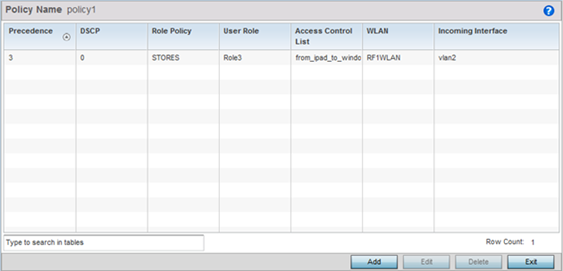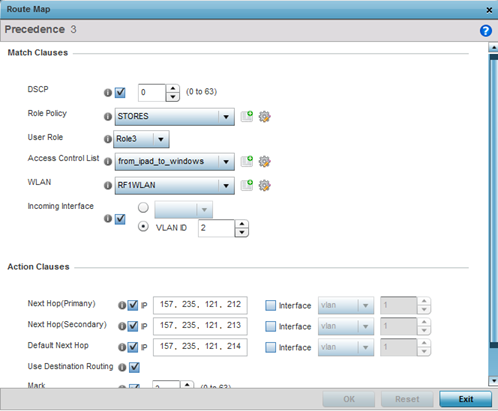Route-maps contain a set of filters which select traffic (match clauses) and associated actions (set clauses) for routing. A routemap consists of multiple entries, each carrying a precedence value. An incoming packet is matched against the route-map with the highest precedence (lowest numerical value). If it matches, the routing decision is based on this route-map. If the packet does not match the route-map, the route-map entry with next highest precedence is matched. If the incoming packet does not match any of the route-map entries, it‘s subjected to typical destination based routing. Each route-map entry can optionally enable/disable logging.
Each route map entry has a set of match and set (action) clauses. ACL rules configured under route map entries merge to create a single ACL. Route map precedence values determine the prioritization of the rules in this merged ACL. An IP DSCP value is also added to the ACL rules.

Note
A packet should optimally satisfy all the match criteria, if no match clause is defined in a route-map, it would match everything. Packets not conforming to any of the match clauses are subjected to normal destination based routing.To define a PBR configuration:


| Precedence | Lists the numeric precedence (priority) assigned to each listed PBR configuration. A routemap consists of multiple entries, each carrying a precedence value. An incoming packet is matched against the route-map with the highest precedence (lowest numerical value). |
| DSCP | Displays each policy‘s DSCP value used as matching criteria for the route map. DSCP is the Differentiated Services Code Point field in an IP header and is for packet classification. Packets are filtered based on the traffic class defined in the IP DSCP field. One DSCP value can be configured per route map entry. |
| Role Policy | Lists each policy‘s role policy used as matching criteria. |
| User Role | Lists the user role defined in the Role Policy. |
| Access Control List | Displays each policy‘s IP ACL used as an access/deny filter criteria for the route map. |
| WLAN | Displays each policy‘s WLAN used as an access/deny filter for the route map. |
| Incoming Interface | Display the name of the Access Point WWAN or VLAN interface on which the packet is received for the listed PBR policy. |

| DSCP | Select this option to enable a spinner control to define the DSCP value used as matching criteria for the route map. DSCP is the Differentiated Services Code Point field in an IP header and is for packet classification. Packets are filtered based on the traffic class defined in the IP DSCP field. One DSCP value can be configured per route map entry. |
| Role Policy | Use the drop-down to select a Role Policy to use with this route-map. Click the Create icon to create a new Role Policy. To view and modify an existing policy, click the Edit icon. |
| User Role | Use the drop-down menu to select a role defined in the selected Role Policy. This user role is used while deciding the routing. |
| Access Control List | Use the drop-down menu to select an IP based ACL used as matching criteria for this route-map. Click the Create icon to create a new ACL. To view and modify an existing ACL, click the Edit icon. |
| WLAN | Use the drop-down menu to select the Access Point WLAN used as matching criteria for this route-map. Click the Create icon to create a new WLAN. To view and modify an existing WLAN, click the Edit icon. |
| Incoming Interface | Select this option to enable radio buttons used to define the interfaces required to receive route-map packets. Use the drop-down menu to define either the Access Point‘s wwan1 or pppoe1 interface. Neither is selected by default. Or, select the VLAN ID option to define the Access Point VLAN to receive route-map-packets. |
| Next Hop (Primary) | Define a first hop priority request. Set either the IP address of the virtual resource or select the Interface option and define either a wwan1, pppoe1 or a VLAN interface. In the simplest terms, if this primary hop resource is available, its used with no additional considerations. |
| Next Hop (Secondary) | If the primary hop request were unavailable, a second resource can be defined. Set either the IP address of the virtual resource or select the Interface option and define either a wwan1, pppoe1 or a VLAN interface. |
| Default Next Hop | If a packet subjected to PBR does not have an explicit route to the destination, the configured default next hop is used. This value is set as either the IP address of the next hop or the outgoing interface. Only one default next hop can be defined. The difference between the next hop and the default next-hop is in case of former, PBR occurs first, then destination based routing. In case of the latter, the order is reverse. Set either the next hop IP address or define either a wwan1, pppoe1 or a VLAN interface. |
| Use Destination Routing | It may be a good idea to select this option to default back to destination based routing if none of the defined hop resources are reachable. Packets are dropped if a next hop resource is unavailable and fallback to destination routing is disabled. This option is enabled by default. |
| Mark | Select this option and use the spinner control to set IP DSCP bits for QoS using an ACL. The mark action of the route maps takes precedence over the mark action of an ACL. |